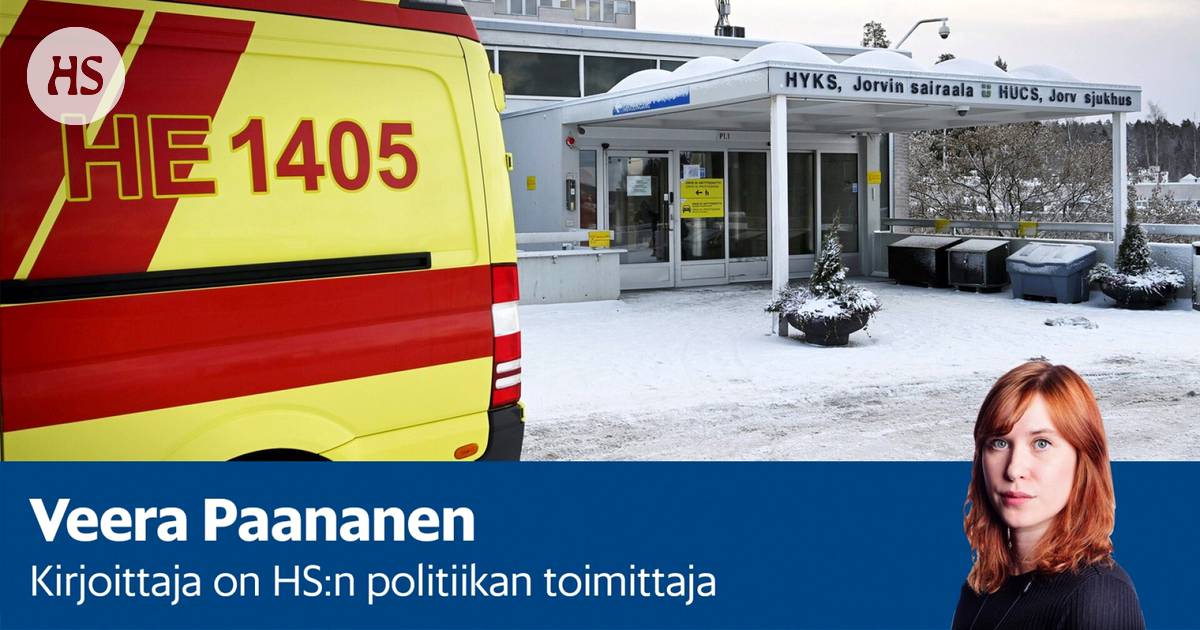Welfare areas should shift the focus of treatment to primary health care. It will be a slow process, writes HS’s political reporter Veera Paananen in her analysis.
“Situation is really creepy.”
In an interview with HS, this is how Hus Akuuti’s branch manager described the congestion in the emergency room at Espoo’s Jorvi Hospital Maaret Castrén.
On Tuesday, it was reported that Jorvi’s emergency room is so badly congested that ambulances have not been able to bring patients there for ten days. Acuta in Tampere is also increasingly in a situation where there is absolutely no place for a patient coming to the emergency room.
Patients suffering from heart problems may then have to wait in the ambulance attached to a monitor.
Read more: Ambulances have not been able to bring patients to Jorvi Hospital for 10 days: “The situation is horrible”
Read more: Patients wait days for access to follow-up care – “Every corner is full”
Emergency services the situation speaks of a different welfare state than what we are used to. In Finland, it has been quite easy to trust that by going to the emergency room at the latest, you will get treatment for your problem.
The root cause of the problems lies in the word “finally.” The health care burden should look like a pyramid: the broad base is primary health care, where the patient’s problems are treated in good time. When the problems cannot be prolonged, the top of the pyramid, i.e. specialized medical care, is needed as little as possible.
However, many municipalities struggling with financial problems have for years saved on basic health care, and have abolished, for example, the inpatient departments of health centers. As a result, more and more customers have flowed into specialized medical care. The end result looks like an erupting volcano instead of a neat pyramid, where the number of patients in the emergency room swells recklessly.
There have also been bad congestions in the Tampere University Hospital’s emergency room in Acuta.
A year The important task of welfare areas starting at the beginning is to reverse the direction of development. It means that more money and employees must be put into primary health care.
The task is not only important for promoting health, but also for the national economy: specialized medical care is particularly expensive. Aging Finland needs to be saved, and that’s why people should be cared for in the municipality’s health and social care center rather than in the hospital’s intensive care unit.
At the moment, however, it seems that the reversal will be slow. It is difficult to imagine a situation where the welfare regions could at once tear a lot of money from specialized medical care and reinvest it in primary health care.
An example of the situation was already seen in Uusimaa, when the Helsinki and Uusimaa hospital district (Hus) announced that it was planning to close the emergency rooms in Malmi, Lohja and Porvoo. In the area, the plans were thwarted once more, and the Husi group board decided to return the savings list for a new preparation.
In order not to have to carry out all the cuts, the welfare regions of Helsinki and Uusimaa must give Hus more money. That money, on the other hand, is probably out of the very basic services that should be invested in now.
Deputy head of department Kirsti Ihalainen adjusted the bed of a 100-year-old patient in the observation room of Jorvi’s emergency department on Wednesday.
Social security reform in accordance with the spirit, wider shoulders should be the solution to the problem: loose money should be found when the municipalities are combined into a larger welfare area.
However, there doesn’t seem to be anything extra. HS reported in November that almost all welfare areas are making a deficit budget for next year.
Read more: HS found out: All but one welfare area will make a loss next year
Regions should cut their expenses so that they can balance their finances and transfer resources to primary health care. So far, however, large adaptation measures have yet to be made in the regions.
Saving is not easy for many reasons. HS said on Tuesday that some regions find the strict debt rules to be a problem: if the region does not get a loan, it may not be able to invest, for example, in digital services that bring savings.
Read more: New concern in welfare areas: Investments are decided by ministry officials, not councillors
The regions are also bound by law, for example, to rent their current premises for the next three years, which means that the service network will not be able to cut back immediately either.
On the other hand, there has been no attempt at savings on the part of the government either. For example, the minister of municipalities Sirpa Paatero (sd) has hoped for patience from regions struggling with funding. The funding of the regions will not be reconciled until 2025, and there will be an additional pot for next year’s funding at the beginning of 2024.
“
“There are elderly people who need hospital care in home care, from where, for example, they come to the emergency room by ambulance because of a fall.”
Economic the future therefore looks foggy in the welfare area. The task of the new government is to decide whether to increase the basic funding of the regions. Finland’s debt burden has swelled, and other areas of society than social security are also fighting for money.
In addition, the labor shortage has become an even bigger problem than money. This can be seen, for example, in the fact that hospitals in various parts of Finland have had to be closed. Thus, elderly people who need hospital care are in home care, from where, for example, they come to the emergency room by ambulance due to a fall.
The message coming from welfare areas is that tightening the rationing of nurses will make the situation worse. In itself, hardly anyone is against improving round-the-clock care, but the problem is that the strict sizing binds the nurses to one place. Care places have also had to be taken out of use because the dimensions cannot be filled.
In this case, it can happen that an elderly person who needs care is at home. When the elderly person’s condition suddenly worsens, we take the ambulance to the emergency room again.
Maaret Castrén, Hus Akut’s branch manager.
“Quite for real.”
These words of affirmation used by Maaret Castrén of Hus have been heard many times in recent months in interviews and background discussions with social security professionals.
The serious consequences of the labor shortage really begin to dawn at the same time as the welfare regions start their operations. The pressure from the top end of the social welfare pyramid should be eased so that people do not die waiting in the emergency room queue.
If employees cannot be scratched significantly more, the welfare areas have no other option than to think about what can be left undone.
#Analysis #Finland #longer #count #treatment #emergency #room #latest #root #word #latest





/s3/static.nrc.nl/wp-content/uploads/2024/04/pakistan-weather-flood.jpg)



